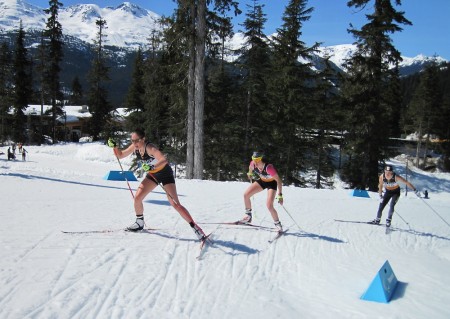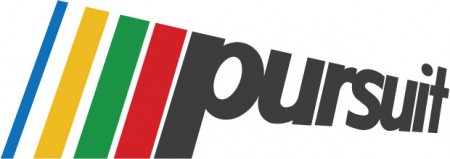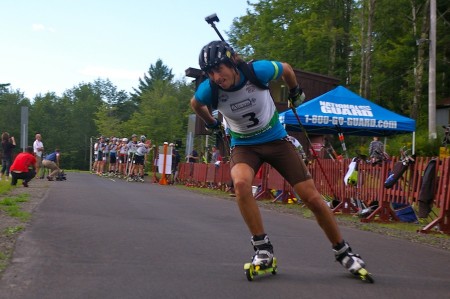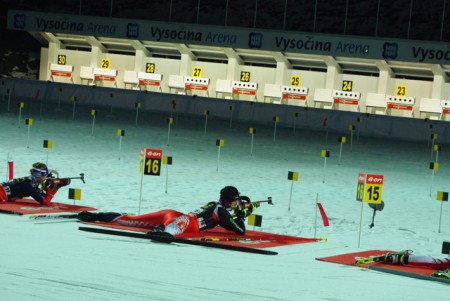
A new tool for athletes is taking Canada by storm: Pursu.it, a crowdfunding tool made specifically for athletes and based on the Kickstarter model.
In the nordic community, biathlete Megan Imrie – who we interviewed this summer about her efforts to revitalize after a bummer season – was the first to try it out. Launching in June, she set out to raise $10,000 to pay for the first part of her season leading up to World Cup qualification.
As in all Pursu.it campaigns, Imrie launched with a video introduction. She explained the ups and downs of her season, why she needed funding, and exactly what it would be used for. Imrie used her facetime to explain her roots on a ranch in Manitoba: alongside the footage of her racing in World Cups, there was Imrie in the barn, mucking out stalls. Besides being a top-level athlete, the undertone was that she was also the Canadian next door, hardworking and humble.
In 60 days, she raised $14,870. Other athletes took notice.
“We hadn’t heard too much about Pursu.it before Megan started her campaign, and after seeing how successful it was for we thought it would be worthwhile to try it out,” fellow biathlete Rosanna Crawford told FasterSkier in an e-mail. “She also mentioned that it was a great approach to raising funds.”
Crawford and longtime partner Brendan Green started a joint campaign to raise $13,000. While Crawford is pre-qualified for the Olympics based on a stellar World Cup season in 2013, Green was sidelined for the entire year based on a back injury sustained near the end of the 2012 season which proved very difficult to treat. He’s back in action, and raced well at North American Rollerski Biathlon Championships this summer, but isn’t starting the Sochi hunt with the support that might otherwise have been available.
Making their intro video was fun, Crawford said, but also tough: “Every step of the way the company helped us out. We made one video and based on the feedback they gave us, we ended up re-filming certain portions to reach out to a bigger audience… Let’s just say that Brendan and I won’t be able to fall on an acting career when we are done biathlon!”

With 24 days left in their campaign, Green and Crawford have already raised over $18,000.
Fellow World Cup biathlete Zina Kocher has now started a campaign as well; with 35 days to go she’s about halfway to her $14,000 goal. It’s undeniable that the crowdsourcing model is a huge boon to the Canadian biathlon community.
But that grows out of an ugly truth. Why is this tool suddenly so popular among biathletes? Unfortunately, says Crawford, even more than in other sports, biathletes are forced to go to extremes to fund their careers. One of the women referenced the nude calendar they made to fund their quest for the 2010 Olympics.
“The fact that we have to try and raise funds like this is definitely a result of Canada’s biathletes being way underfunded,” she wrote. “Biathlon Canada is lacking a corporate sponsor and every year the training and tour fees increase for the athletes. It’s getting more difficult each season for national team athletes to find the funds to race biathlon. It’s an unfortunate situation and I think the team will be facing problems in the very near future with athletes staying in the program if things don’t change soon.”
From Experience, the Birth of Better Funding
 Biathlon might be struggling, but regardless of the health of a sport’s national governing body, Pursu.it co-founder Julia Rivard – herself a former Olympic kayaker – saw that becoming, and then remaining, a top-level athlete requires great personal and financial sacrifice in Canada.
Biathlon might be struggling, but regardless of the health of a sport’s national governing body, Pursu.it co-founder Julia Rivard – herself a former Olympic kayaker – saw that becoming, and then remaining, a top-level athlete requires great personal and financial sacrifice in Canada.
“I was lucky enough to have the support of my family and never really struggled, but after the Olympic Games I felt that continuing to support my career through the support of my family was selfish, and that I had to start contributing financially,” Rivard told FasterSkier. “I only raced kayak competitively for 4 years and have always felt that I could have done much more in sport had I continued.”
After retirement, she went into the corporate world, where she saw many requests for sponsorship from athletes. That hammered home the idea that she was not alone in having to scrounge for money to be an athlete.
“Athletes would approach me for help time and time again to develop sponsor pitches to help get their training funded,” she said. “I cannot say that may were successful, and like me, they may ended their careers early. I have always thought there has to be a better way to support young people who are working so hard towards specific goals.”
Rivard and her business partner Leah Skerry now work in tech and also own the website Norex.ca. When the Kickstarter/Indiegogo model emerged, they immediately sensed an opportunity to combine the two things they knew best: sports and technology. To raise their last chunk of capital, they actually used Indiegogo, in part to see how it worked from the other end. Pursu.it lauched on September 30, 2012, offering the same model but only for athletes.
“We want to be the household name for fans who what to see their donation dollars go to inspiring young Canadian athletes trying to reach their dreams,” says Rivard, whose company also promotes the Twitter hashtag #mymoneysondreams. “To do this we need a strong brand something that is memorable – sticky! This would not be able to be done on a platform with many different types of campaigns.”
The “microfunding” model has a few universal benefits, for instance cutting out the middleman and the red tape. For athletes, this means that donors can directly support them, instead of contributing to a national governing body and being unsure what their money is actually being spent on.
But Rivard also sees more benefits for athletes. Pursu.it gives them a bigger platform that is not limited to their own sport and its fans, and makes asking for money a little less awkward than groveling face-to-face before friends and neighbors. And lastly, it’s a permanent tool to maintain connections.
In Practice

How does Pursu.it do that? After potential donors watch an athlete’s video, the site offers people two ways to get involved with an athlete’s campaign. Preferably they become a “team member,” who contributes a monetary donation. But there’s also the option to be just a fan, and receive updates on the athlete’s Pursu.it page. Crawford and Green, for example, currently have 45 teammates and 3,370 fans on their Pursu.it campaign page.
Team members are offered additional benefits as an incentive to contribute. Like on Kickstarter, the athletes offer “givebacks” for different levels of contributions. For small donations, most start by offering regular e-mail updates from the competition trail or postcards from Europe. Fostering these connections, Rivard hopes, will make each athlete’s career more sustainable in the long run.
“[Pursu.it] has brought together fans who are already a part of the particular athlete’s networks, but there is also a segment of donations that comes from strangers who have been inspired by the stories on Pursu.it,” she said. “We hear a lot from parents of young kids who have a dream to one day be in the same position as the athlete on Pursu.it, as well as corporations who want to connect for a more formal partnership.”
Larger contributions, too, shouldn’t be one-time donations that a team member will forget about: that’s where more memorable and bigger givebacks come in. Among the givebacks that biathletes have offered for larger contributions are framed and signed photos, a ski session with the athletes, a stay at a ranch in Manitoba or a cabin in Canmore, race bibs or old skis or team suits, personal recipes, skype sessions, and cooking lessons. That builds a community and a personal connection.
Or, in many cases, the givebacks simply strengthen a community that already exists. One way to use Pursu.it is to organize existing supporters more effectively.
“It’s been incredible to see how many of the donations have come from people either Brendan or I know,” Crawford wrote. “The community in Brendan’s hometown of Hay River, Northwest Territories, have really stepped up to help support us. Canmore has also been great, but there are a lot of athletes in Canmore who need help funding their dreams. There have been a few donations from abroad but most have come from Western Canada.”
You could hypothesize that the reason that Kocher’s campaign has not yet met its goal might be because as the third biathlete to start a Pursu.it page, there’s a bit of donor fatigue in the small community. But Rivard and Crawford dismiss that notion.

“The great thing about Pursu.it is that we can reach out to our own home communities,” Crawford wrote. “Megan had Manitoba, Zina has Red Deer, and Brendan and I have the North and Canmore. Of course the people who know Megan might not donate to Zina or I, but the great thing is that even the smallest donations are welcome, and every little bit helps. If each person who clicks becomes a fan and decides to donate $10-20, that can add up really quickly!”
Rivard agrees, and added that the small donation amounts should mean that people aren’t so reluctant to donate to multiple campaigns.
“There are still so many people who have never heard of the platform I don’t see [donor fatigue] being a problem,” she said. “In addition, the donations are normally not huge so fans can often justify making a few smaller donations over a period of several months.”
And as Crawford said, those little contributions add up to an easier winter for underfunded athletes. In Imrie’s recent video thanking her contributors, she seemed overwhelmed by the level of support she was receiving. Crawford seems similarly astonished – and relieved.
“It makes a huge difference,” she wrote. “If we can cover our team fees, then we can put more money towards eating the best food, getting physiotherapy, buying ammunition etc. Especially with Brendan’s back injury – in order for him to be at the top of the game he really needs to keep his back in check. With this being an Olympic year, it’s nice to have one less thing weighing down on our minds. Last year was pretty hard on me financially and that made things extra stressful. This year it feels already like a weight has been lifted.”
Links:
Green and Crawford campaign
Kocher campaign
bonus: 2010 Athletes In Motion CTV video, featuring Imrie and Crawford as retro frontierswomen training in the woods: Bring It Home
Chelsea Little
Chelsea Little is FasterSkier's Editor-At-Large. A former racer at Ford Sayre, Dartmouth College and the Craftsbury Green Racing Project, she is a PhD candidate in aquatic ecology in the @Altermatt_lab at Eawag, the Swiss Federal Institute of Aquatic Science and Technology in Zurich, Switzerland. You can follow her on twitter @ChelskiLittle.



